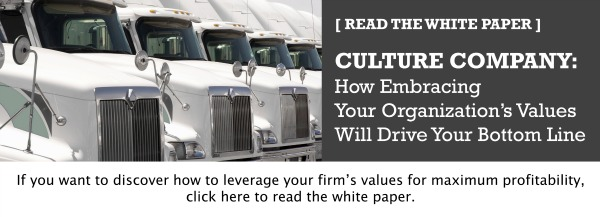 CHRIS TANKE, Relationship Manager
CHRIS TANKE, Relationship Manager
& BRIAN KAMINSKI, Account Executive at HNI
Strong organizational culture is an asset to be leveraged for the long haul.
Companies with a strong organizational culture always have a compass for decision-making and internal alignment. Leaders and employees easily can answer, "What comes next?" for each choice they make.
In the transportation industry, firms with a strong organizational culture balance safety and operational efficiency by allowing their values to guide strategy. These companies with a culture of safety work their plan and diligently measure success toward goals, all within the framework of their culture. Efforts are streamlined, and talent deeply understands how everyone has a unique role to play to support the mission — and each other, with limited or no redundancy.
Here are a few simple ideas to help leaders make progress toward becoming a Culture Company. What would you add to this list?
1. VALUES
Lean on your workforce to identify your company’s core values. Let these unshakable beliefs emerge organically. Then it’s up to leaders to communicate these values and consistently reinforce them in everything your company does.
2. DRIVE THE STRONG ORGANIZATIONAL CULTURE
The CEO needs to be the emblem of what the company’s culture is. Front-line managers need a good example from a leader who walks the talk.
3. METRICS
Establish your leading and lagging metrics and track them. Share the results with the folks who are responsible for them. Feedback and accountability are then based on objective results vs. subjective observations.
4. CONSISTENT ACCOUNTABILITY
Much hard work in establishing values can go by the wayside if we are not holding employees consistently accountable. Accountability for corporate core values starts at the top and must be practiced between peer employees as well. Again, it goes back to all talent walking the talk and calling out those who don't.
5. DON’T ACCOMMODATE
Just because a poor decision came from a good person doesn’t make it OK. Good people making bad decisions can sink a company fast. Make sure your corrective action policy is transparent and practiced fairly.
6. DEVELOP A COMMON LANGUAGE
The language in your company should revolve around a culture of excellence. Make this language come alive in everyday workings and not just in management meetings. Keep your ears peeled for phrases that capture how you treat each other and how you treat customers and prospects.
7. ASK FOR HELP
Find and utilize risk management advisors who can help drive the process and hold the organization accountable. An experienced advisor can dramatically accelerate your culture evolution.
In trucking, for example, the big benefit of a Culture Company environment is that you no longer have to manage safety because everyone is managing safety. Everyone lives the culture and makes decisions based on that culture. Because of this, everyone can reap the benefits of improved profitability.
Over to you: What's the hardest part of building a strong organizational culture? Who have been the greatest champions (maybe to your own surprise) of corporate core values? Please share in comments.
Related Posts:
How Corporate Core Values Differentiate Culture Companies from the Pack
Tracy Morgan Crash Shines Spotlight on Culture of Safety in Trucking
Why More Employers are Creating a Culture of Transparency
WHITE PAPER: Managing People Risk: The Human Side of the Equation
.png?width=69&height=53&name=Acrisure%20Logo%20(White%20Horizontal).png)

 CHRIS
CHRIS 
